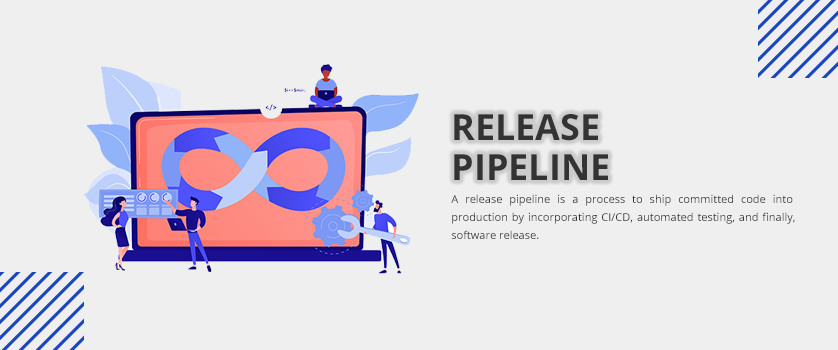


A release pipeline is a process to ship committed code into production by incorporating CI/CD, automated testing, and finally, software release. It includes many steps like:
A release pipeline is like a workflow where the goal of all the events is to successfully deploy the software. And to achieve this precision, events are organized in such a way that each successful event triggers the next event. If any event fails, either it notifies the user or works in a pre-defined manner.
To understand how pipelines work, please look at the following steps:
To use Azure pipelines, you need to develop a release pipeline for your project. And it starts after you specify the artifacts which are responsible to make up the application and the release pipeline.
Let’s understand both one by one...
An artifact is a component of your application that can be deployed, and it is produced through continuous integration or a build pipeline. These pipeline releases can deploy artifacts that are produced by a wide range of artifacts sources, like Azure pipelines build, Jenkins, or TeamCity.
You should also define the release pipeline by using stages and restricting deployments by using approvals. For example, you can define automation in each stage using jobs and tasks, and trigger deployment automatically using variables.
Before the introduction of multi-stage YAML pipelines, there was a concept called pipelines in Azure pipelines. If you want to create a build pipeline you have to create or build software binaries like .net or ng builds, and you need to store these artifacts in the Azure DevOps location.
Then you also need to have a release pipeline that gets triggered by these builds and deploys these software binaries to one or many stages.
The reason for having two separate pipelines (build and release) was to build a specific version of your software only once, and then you can use the same binaries in each of the target environments like development, test, or production.
However, with the new pipeline, you only use the first stage to build your artifacts and the next stage is used to deploy them. The concept of building two separate pipelines was included in the classic pipelines but as the Azure DevOps has evolved now it is known as Azure pipelines.
There are three core principles that you will see throughout the release pipeline and they are:
AWS CodePipeline: AWS CodePipeline is a fully managed, continuous delivery service that enables developers to connect existing tools and systems. It allows organizations to set up different stages of their software release process using the console interface like AWS CLI, AWS CloudFormation, or AWS SDKs.
Using AWS code pipeline, users can easily specify which test they want to run, and at the same time, they can customize the steps and dependencies required for application deployment. With AWS pre-built plug-ins or their custom plug-ins, developers can integrate these into the AWS code pipeline for the release process. To understand how this process works take a look at the example:
You can pull source code from Github; use Jenkins as your build server; run load tests using third-party services; you can pass on deployment information to the custom operation dashboard. Automating all the processes like build, test, and release allows development teams to easily test each code and catch and fix bugs while they are simple and small. By following this process, the development team ensures the quality of their application.
Azure Pipelines: It’s a cloud service that automatically builds and tests code projects, and at the same time makes them available to other users. It works with many languages and also enables continuous integration and continuous delivery so that the operation of testing, building, and deployment runs constantly. It runs on Linux, macOS, and Windows.
While using Azure pipelines, users can deploy containers to individual hosts or the Kubernetes environment as Azure pipelines allow users to explore and implement a wide range of community-built build, test, and deployment tasks. It can implement continuous software delivery to any cloud, including Azure, AWS, and GCP. Besides this, it helps visualize deployment to any number of interdependent stages and ensures fast continuous integration and continuous delivery pipeline for every open source project.
Development teams aim to release the finest product by using minimum effort and resources. And to achieve such a level of precision, you need to create a workflow where you can automate various tasks from beginning to end. Release pipeline is the same process. Here you develop a workflow so that there should be lesser human intervention to produce quality software.